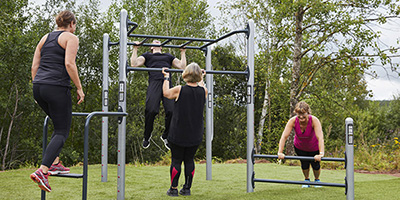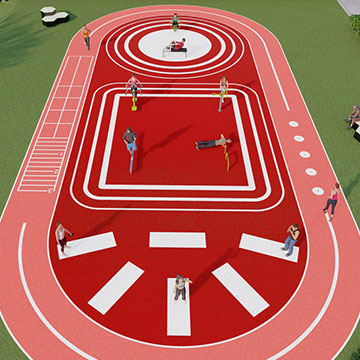Fill your basket with products by clicking "Add to my collection" from any product page. This can be found either within the product options panel or below the product image. Collections can be saved, and stored, within your HAGS Connect account or create and print your own custom brochure, download the files you need in one go, or to request a quote.
How to design a successful outdoor gym
Before you break ground on your outdoor fitness project, ensure you have everything you need for its success. With careful planning and design, you can have a popular outdoor spot for anyone wanting to get active. Plus, with a properly located gym, you can draw people from nearby exercise trails to take advantage of your site’s amenities and add strength training to their routine.
To ensure that your outdoor gym is up to the highest safety standards, here are some tips to keep in mind when designing and creating your space. These are the steps we would be able to help and guide you with, from start to finish.

1. Budget
It is important to consider your budget before attempting a big project on building an outdoor fitness area for your community because it will help you to ensure that you have enough resources to complete the project. Without a budget, you may underestimate the cost of the project and end up with an unfinished project or running out of money before the project is complete.
Additionally, having a clear budget will help you to identify potential sources of funding or sponsorships that you could use to fund the project. Finally, a budget will help you to ensure that you are making the best use of the resources available to complete the project efficiently and cost-effectively.
Your budget will determine the size and amount of equipment you can fit into an outdoor gym. Grant funding or donations may contribute to the budget for public outdoor gyms. If you are building a workout facility outside for a private community, fees from residents may cover the cost.
For both public and private construction projects, you might need to petition organisations in charge of finances for approval. Consider local government infrastructure and whether the outdoor gym will be part of an existing park or a new venue.
However you get approval for the project, ensure you have an accurate budget for building the gym space because you will need to use those funds for the site planning, equipment and installation processes.
2. Location
It is important to consider the location of your outdoor fitness area before attempting to build it because the location you choose can determine the success of the project. Factors such as proximity to other amenities, access to public transportation, and the availability of outdoor spaces for users to exercise in should all be taken into consideration when deciding where to build the outdoor fitness area.
If the location chosen is not convenient for users, then the project may not be as successful as it could be. Additionally, the local climate should be taken into account to ensure that the outdoor fitness area can be used year-round.
The ideal placement is a location that draws people’s attention and is convenient for those who want to use it. For public parks, set up the outdoor gym near other workout options, such as running or biking trails. Make sure to have adequate parking nearby for those who drive to the park instead of walking.


3. Site planning
Site planning is important before attempting a big project on building an outdoor fitness area for your community because it can help you determine the most suitable location and space for the project. Site planning can also help you identify potential risks, such as environmental hazards or access issues, that can affect the success of the project.
Additionally, site planning can help ensure that the project is compliant with local zoning and building codes. Finally, site planning can help you determine any potential costs associated with the project, allowing you to effectively budget and plan accordingly.
The site you choose for the gym needs to have good drainage and enough shade to keep the area comfortable in the summer. You may need to add additional soil to sites with low spots to prevent water ponding, which may present a safety hazard.
4. Safety
The safety of those who use the outdoor exercise equipment at the site is of the utmost importance. To help protect against vandalism and prolong the lifespan of the installation, safety features such as durable materials and fixtures should be used.
Adding lighting such as floodlights can enable people to use the equipment even after dark or on overcast days. Not only does this provide extra security and peace of mind, but it also reduces the potential for vandalism, as the perpetrators will be more visible and easier to identify. In this way, the outdoor gym can remain in good condition and be enjoyed by users for a longer period of time.
5. Target users
To identify the target audience of the outdoor gym site, consider the context in which it will be used. For example, if it is part of an apartment complex that caters to young, single people, fitness classes and socializing opportunities should be included.
On the other hand, if the gym is located near a jogging trail, more cardio equipment may not be necessary.
6. Accessibility
Your outdoor gym area must be accessible. Where possible ensure there are reserved, accessible parking spots close to the gym and that all walkways and ground surfaces are suitable for people who use mobility devices.
7. Equipment to install
Choose the right equipment to install for your outdoor facility. Consider your budget and look for durable outdoor fitness pieces designed to last. It is essential that each station have enough space on all sides to allow a person to use it safely, without overlapping another station.
Additionally, including signage with visuals that show the right way to use the equipment is recommended. This is particularly helpful for people who may not know the language, as visuals can convey the right action more effectively. You can also pair visuals with text in various languages.


8. Surfacing
The outdoor gym space should have a ground surface which is easily accessible. Two of the most common choices are rubber wetpour surfacing and loose-fill surface material. The option you select will be determined by your budget and the type of equipment you plan to install.
9. Promotion
To make sure your newly-constructed outdoor gym is used by the public, start off with a grand opening celebration to draw attention to the site. Invite fitness professionals to demonstrate the different pieces of equipment, and for community areas, make sure to share the news with area residents.
Posting signs in common areas and updating websites should be part of a broader campaign to ensure consistent promotion of the gym. With the right strategy, the investment will pay off in terms of more users.
If you’re looking for inspiration and some ideas on what outdoor gyms might look like, please click the link below to view our range of examples.
View InspirationIf you have any questions or would like to make an enquiry about our outdoor gym equipment, please get in touch.
Contact Us
HAGS Aneby AB
Grännavägen 7 578 33 Aneby
Contact Us
If you have questions or would like to know something about our products, you can contact us by phone, fax, email or directly on our website. If you do not know who at HAGS you should talk to, or if you would like to come in contact with a specific person at HAGS, you are welcome to call our switchboard to get connected to the right person.














































































Follow HAGS: